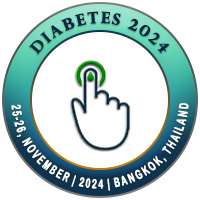
Montosh Chakraborty
AIIMS Mangalagiri, IndiaTitle: Predicted HbA1c and fructosaminated HbA1c: Evaluating their role as an indicator of glycemic status in Diabetes Mellitus: A hospital based cross sectional study
Abstract
Background: Glycated Hemoglobin has been a popular investigation to access the glycemic status. It is a marker for intracellular glycation and hence an investigation which can comply with both intracellular and extracellular glycation status is preferred.
Methodology: In this regard, Fructosaminated HbA1c (FHbA1c), Predicted HbA1c (PHbA1c) and Glycation Gap (GG) were evaluated in 57 cases of Diabetes Mellitus (DM) without complication and having a normal serum protein and albumin levels. 57 controls were also evaluated. FHbA1c, PHbA1c and Post prandial Predicted HbA1c (PPHbA1c) were plotted using population linear regression equation and calculated individually against each subject. The statistical calculation were evaluated using SPSS version 21.
Results: FHbA1c, PHbA1c, PPHbA1c and GG were found to be significantly elevated in cases (p value < 0.001). FHbA1c and GG shows significant correlation with the glycemic indices in cases compared to controls. The correlation with FBS and PPBS increases as we move from controls to cases. Area under curve (AUC) in case of FHbA1c is 96.8% and cutoff level of 5.85% can result in sensitivity of 88.2% and specificity of 90% for the diagnosis of DM.
Conclusion: FHbA1c can be used as an additional investigation in cases of DM. Along with GG, it is increased in DM and correlates with the glycemic indices. It has a decent AUC on plotting ROC. Thus, FHbA1c and GG can be used as a part of Glyco-Metabolic Profile and can provide insight into the individualised glycation tendency of the cell.
Biography
Montosh Chakraborty has completed his MBBS MD (Biochemistry) from a premier medical college in India. He has over 10 years of experience in the relevant field as academician, laboratory specialist and researcher. Presently he is working as faculty in All India Institute of Medical Sciences. He has many publications in high end journals and has been contributing as a reviewer for many journals. He has over 187 citations and h index is 8.

